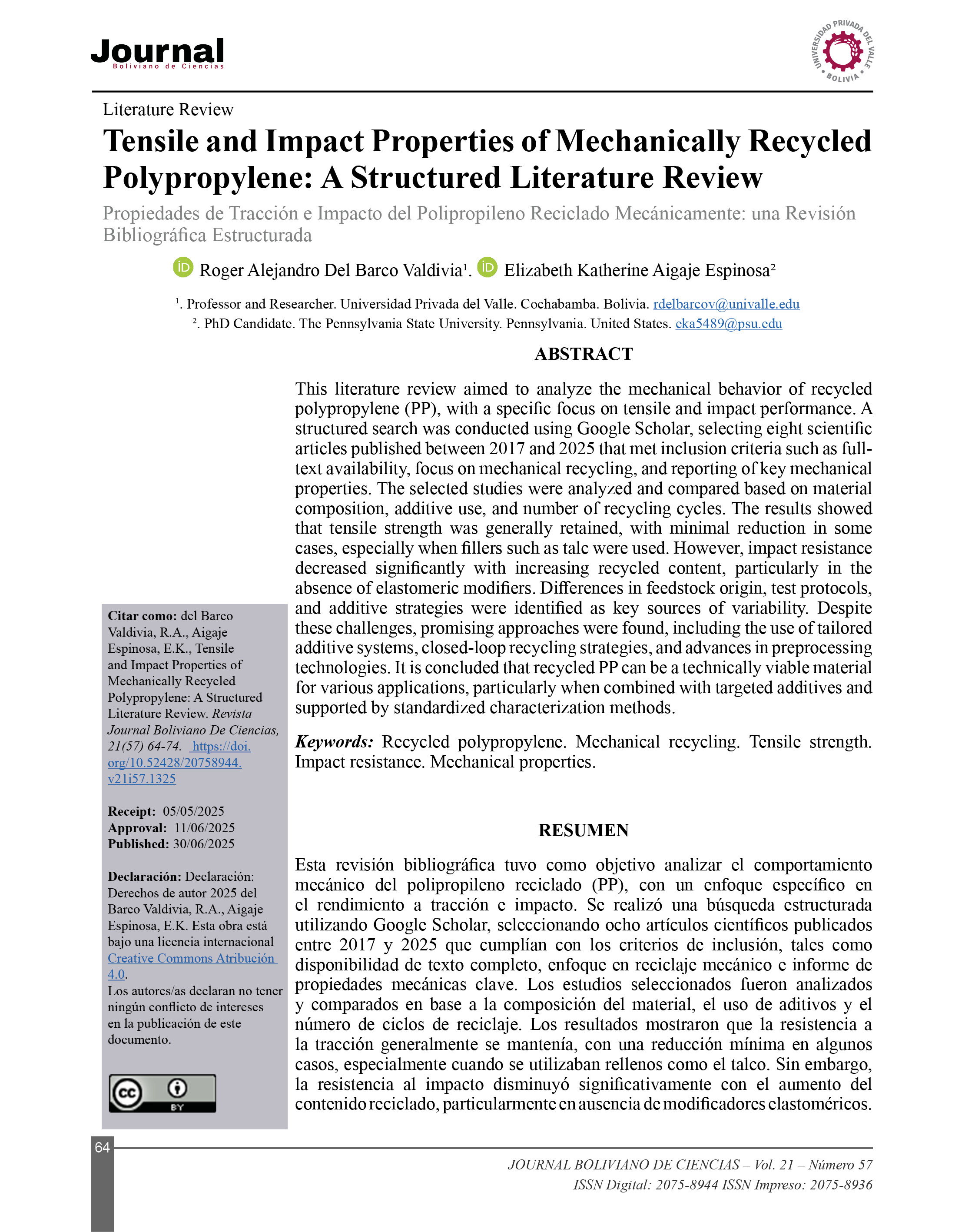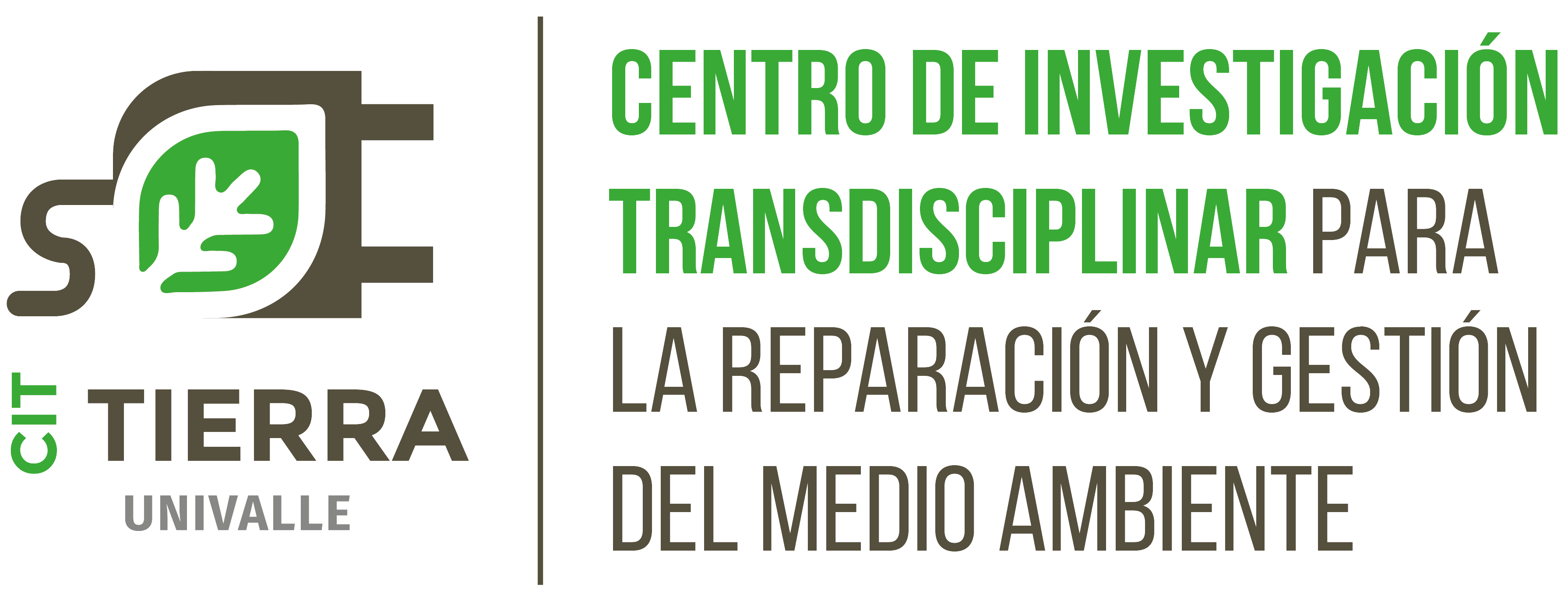Tensile and Impact Properties of Mechanically Recycled Polypropylene: A Structured Literature Review
DOI:
https://doi.org/10.52428/20758944.v21i57.1325Keywords:
Recycled polypropylene, Mechanical recycling, Tensile strength, Impact Resistance, Mechanical propertiesAbstract
This literature review aimed to analyze the mechanical and thermal behavior of recycled polypropylene (PP), with a specific focus on tensile and impact performance. A structured search was conducted using Google Scholar, selecting eight scientific articles published between 2017 and 2025 that met inclusion criteria such as full-text availability, focus on mechanical recycling, and reporting of key mechanical properties. The selected studies were analyzed and compared based on material composition, additive use, and number of recycling cycles. The results showed that tensile strength was generally retained, with minimal reduction in some cases, especially when fillers such as talc were used. However, impact resistance decreased significantly with increasing recycled content, particularly in the absence of elastomeric modifiers. Differences in feedstock origin, test protocols, and additive strategies were identified as key sources of variability. Despite these challenges, promising approaches were found, including the use of tailored additive systems, closed-loop recycling strategies, and advances in preprocessing technologies. It is concluded that recycled PP can be a technically viable material for various applications, particularly when combined with targeted additives and supported by standardized characterization methods.
Downloads
References
Achilias, D. S., Roupakias, C., Megalokonomos, P., Lappas, A. A., & Antonakou, Ε. V. (2007). Chemical recycling of plastic wastes made from polyethylene (LDPE and HDPE) and polypropylene (PP). Journal of Hazardous Materials, 149(3), 536-542. DOI: https://doi.org/10.1016/j.jhazmat.2007.06.076 PMid:17681427 DOI: https://doi.org/10.1016/j.jhazmat.2007.06.076
Arese, M., Bolliri, I., Ciaccio, G., & Brunella, V. (2025). Post-Industrial Recycled Polypropylene for Automotive Application: Mechanical Properties After Thermal Ageing.DOI: https://doi.org/10.3390/pr13020315 DOI: https://doi.org/10.3390/pr13020315
Aurrekoetxea, J., Sarrionandia, M. A., Urrutibeascoa, I., & Maspoch, M. Ll. (2001). Effects of recycling on the microstructure and the mechanical properties of isotactic polypropylene. Journal of Materials Science, 36(11), 2607-2613. DOI: https://doi.org/10.1023/A:1017983907260 DOI: https://doi.org/10.1023/A:1017983907260
Barbosa, L. G., Cassiano, R. D., & Francesquetti, E. L. (2020). Obtaining an Empirical Equation for Correcting the Melt Flow Index of Virgin and Recycled Polypropylene Mixtures and Analysis of Mechanical Properties of the Blends. Global Journal of Researches in Engineering, 27-34. DOI:
https://doi.org/10.34257/GJREJVOL20IS5PG27 DOI: https://doi.org/10.34257/GJREJVOL20IS5PG27
Barbosa, L. G., Piaia, M., & Henrique Ceni, G. (2017). Analysis of Impact and Tensile Properties of Recycled Polypropylene. International Journal of Materials Engineering, 7(6), 117-120. DOI: https://doi.org/10.5923/j.ijme.20170706.03 DOI: https://doi.org/10.5923/j.ijme.20170706.03
Domingues, M. L. B., Bocca, J. R., Fávaro, S. L., & Radovanovic, E. (2020). Disposable coffee capsules as a source of recycled polypropylene. Polímeros, 30, e2020009. DOI: https://doi.org/10.1590/0104-1428.05518 DOI: https://doi.org/10.1590/0104-1428.05518
Gabriel, D. S., & Ananditto, A. (2020). Effect of Repetitive Recycling on the Mechanical Properties of Polypropylene Blends Based on Material Value Conservation Paradigm. Materials Science Forum, 1015, 70-75. DOI: https://doi.org/10.4028/www.scientific.net/MSF.1015.70 DOI: https://doi.org/10.4028/www.scientific.net/MSF.1015.70
Geyer, R., Jambeck, J. R., & Law, K. L. (2017). Production, use, and fate of all plastics ever made. Science Advances, 3(7), e1700782. DOI:
https://doi.org/10.1126/sciadv.1700782 PMid:28776036 PMCid:PMC5517107 DOI: https://doi.org/10.1126/sciadv.1700782
Kozderka, M., Rose, B., Bahlouli, N., Kočí, V., & Caillaud, E. (2017). Recycled high impact polypropylene in the automotive industry-Mechanical and environmental properties. International Journal on Interactive Design and Manufacturing (IJIDeM), 11(3), 737-750. DOI: https://doi.org/10.1007/s12008-016-0365-9 DOI: https://doi.org/10.1007/s12008-016-0365-9
Matei, E., Râpă, M., Andras, Á. A., Predescu, A. M., Pantilimon, C., Pica, A., & Predescu, C. (2017). Recycled Polypropylene Improved with Thermoplastic Elastomers. International Journal of Polymer Science, 2017(1), 7525923. DOI: https://doi.org/10.1155/2017/7525923 DOI: https://doi.org/10.1155/2017/7525923
Menard, K. P., & Menard, N. R. (2020). Dynamic Mechanical Analysis (3rd ed.). CRC Press. DOI: https://doi.org/10.1201/9780429190308 DOI: https://doi.org/10.1201/9780429190308
Meran, C., Ozturk, O., & Yuksel, M. (2008). Examination of the possibility of recycling and utilizing recycled polyethylene and polypropylene. Materials & Design, 29(3), 701-705. DOI: https://doi.org/10.1016/j.matdes.2007.02.007 DOI: https://doi.org/10.1016/j.matdes.2007.02.007
Poveda, P. N. S., & A e Silva, L. G. (2019). Study of the Influence of Organic Peroxide and Elastomeric Modifier in the Mechanical and Flow Properties of the Recycled Polypropylene. In B. Li, J. Li, S. Ikhmayies, M. Zhang, Y. E. Kalay, J. S. Carpenter, J.-Y. Hwang, S. N. Monteiro, C. Bai, J. P. Escobedo-Diaz, P. R. Spena, & R. Goswami (Eds.), Characterization of Minerals, Metals, and Materials 2019 (pp. 787-792). Springer International Publishing. DOI: https://doi.org/10.1007/978-3-030-05749-7_79 DOI: https://doi.org/10.1007/978-3-030-05749-7_79
Sambyal, P., Najmi, P., Sharma, D., Khoshbakhti, E., Hosseini, H., Milani, A. S., & Arjmand, M. (2025). Plastic recycling: Challenges and opportunities. The Canadian Journal of Chemical Engineering, 103(6), 2462. DOI: https://doi.org/10.1002/cjce.25531 DOI: https://doi.org/10.1002/cjce.25531
Schyns, Z. O. G., & Shaver, M. P. (2021). Mechanical Recycling of Packaging Plastics: A Review. Macromolecular Rapid Communications, 42(3), 2000415. DOI: https://doi.org/10.1002/marc.202000415 PMid:33000883 DOI: https://doi.org/10.1002/marc.202000415

Published
How to Cite
Issue
Section
License
Copyright (c) 2025 Roger Alejandro Del Barco Valdivia, Elizabeth Katherine Aigaje Espinosa

This work is licensed under a Creative Commons Attribution 4.0 International License.
Authors who publish with this journal agree to the following terms:
- Authors retain copyright and grant the journal right of first publication with the work simultaneously licensed under a Creative Commons Attribution License 4.0 that allows others to share the work with an acknowledgement of the work's authorship and initial publication in this journal.
- Authors are able to enter into separate, additional contractual arrangements for the non-exclusive distribution of the journal's published version of the work (e.g., post it to an institutional repository or publish it in a book), with an acknowledgement of its initial publication in this journal.
- Authors are permitted and encouraged to post their work online (e.g., in institutional repositories or on their website) prior to and during the submission process, as it can lead to productive exchanges, as well as earlier and greater citation of published work.














